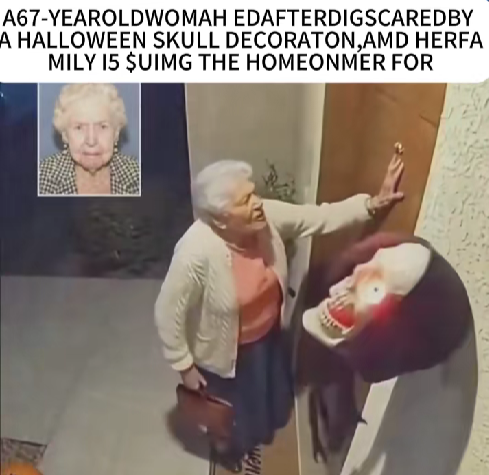What began as a festive Halloween display has turned into a heartbreaking tragedy. A 67-year-old woman reportedly passed away after being startled by a motion-activated skull decoration on a neighbor’s porch. Now, her family is taking legal action against the homeowner, claiming negligence and emotional distress.
The incident occurred in a quiet suburban neighborhood just days before Halloween. According to security footage, the woman approached the house to deliver mail that had been mistakenly placed in her box. As she neared the door, a motion sensor triggered a life-sized skull that suddenly lit up with flashing red eyes and emitted a loud scream.
Startled, the woman is seen clutching her chest before collapsing on the porch. The homeowner, who was inside at the time, rushed out upon hearing the commotion and immediately called emergency services. Despite paramedics’ best efforts, she was pronounced dead at the scene.
The family has since filed a lawsuit against the homeowner, alleging that the Halloween decoration created a “dangerous and unsafe condition” for visitors. Their attorney released a statement saying, “No one expects to lose their loved one because of a holiday prank gone wrong. This could have been easily prevented with consideration and care.”
Neighbors described the woman as kind and gentle, someone who often baked cookies for the kids on the block. “She was the sweetest person,” one local said. “She loved Halloween, too — that’s what makes this so heartbreaking.”
The homeowner, identified only as Mark S., expressed deep remorse and said he never intended to harm anyone. “I’m devastated,” he told reporters. “It was meant to be a fun decoration. I had no idea something like this could happen.”
Legal experts say the case will hinge on whether the homeowner’s Halloween setup can be considered “foreseeably hazardous.” Decorations that include sudden loud noises or flashing lights may pose a risk to individuals with heart conditions, though proving liability in such cases can be complex.
“This lawsuit raises difficult questions about personal responsibility and community standards,” said attorney David Rosen. “While homeowners have the right to decorate, they also have a duty to ensure their property is reasonably safe for visitors — especially when decorations can cause extreme shock.”
The incident has reignited online debates about how far people should go with Halloween pranks. Some argue that hyper-realistic and startling props have become too extreme, while others insist it was an unfortunate accident that no one could have predicted.
In response to the tragedy, local authorities have issued safety reminders encouraging residents to consider the potential health effects of their holiday decorations. “We want everyone to enjoy the season safely,” a spokesperson said. “Please be mindful of how loud, bright, or sudden your displays might be.”
As the community continues to grieve, neighbors have placed flowers and candles near the woman’s home in her memory. Her family has asked for privacy but hopes that their legal action will lead to greater awareness — so that no other family has to face such an unimaginable loss over something meant to bring joy.
